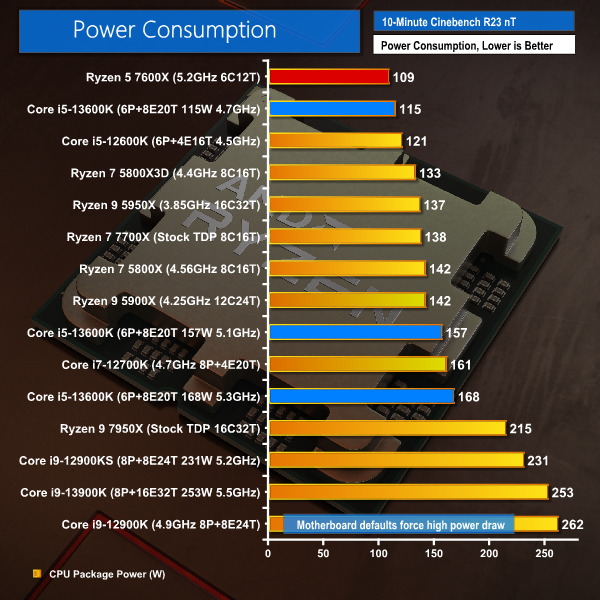For CPU load results, we read the power draw after running 10 minutes of the Cinebench R23 nT all-core rendering test. The same test parameters are used for temperature readings.
The power consumption of our entire test system (at the wall) is shown in the chart. We also include the reported CPU Package Power.
Power Consumption
Power draw readings are accurate to around +/-5W under heavy load due to instantaneous fluctuations in the value.
Looking at power consumption, the 142W PPT-rated Ryzen 5 7600X actually does very well in the current world of energy-sucking PC hardware.
109W for a heavy all-core load situation is fine, and shouldn’t present any major cooler headaches. This translates into 5.2GHz all-core in a Cinebench workload.
Intel’s Core i5-12600K price competitor demands a little more power than AMD’s new chip. But the newer – and more expensive – Core i5-13600K demands a considerably higher level of power draw unless it is constricted to a 115W TDP mode, as tested by Leo.
Temperatures
Temperature recordings were taken using a 360mm AIO CPU cooler. Ambient temperatures were around 25°C.
Despite offering relatively modest power draw figures, Zen 4 continues to run very hot in the Ryzen 5 7600X form.
A load temperature of 91C under a 360mm AIO cooler is very high, but the reality is that AMD is pushing the chip towards its 95C limit to try to eke out every last drop of frequency.
It’s not really the actual power draw that is driving this high temperature; that’s clear by looking at the higher core count Ryzen 7000 alternatives. Instead, it’s the high operating voltage that results in lofty operating temperatures.
91C is nothing to be concerned by, but it could cause some headaches for managing CPU cooler and chassis fan speeds on motherboards or hardware with less tuneable fan control options.
 KitGuru KitGuru.net – Tech News | Hardware News | Hardware Reviews | IOS | Mobile | Gaming | Graphics Cards
KitGuru KitGuru.net – Tech News | Hardware News | Hardware Reviews | IOS | Mobile | Gaming | Graphics Cards





